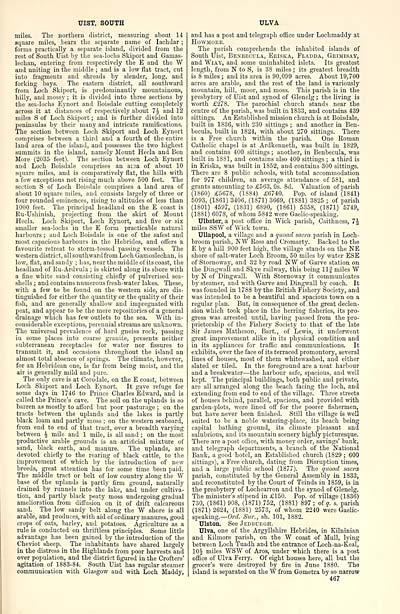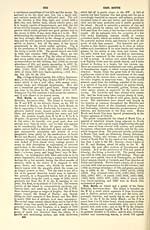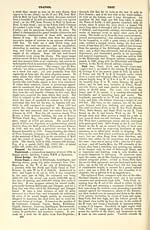Ordnance gazetteer of Scotland > Volume 6
(289) Page 467
Download files
Complete book:
Individual page:
Thumbnail gallery: Grid view | List view

UIST, SOUTH
miles. The northern district, measuring about 14
square miles, bears the separate name of Iachdar ;
forms practically a separate island, divided from the
rest of South Uist by the sea-lochs Skiport and Garnas-
lechan, entering from respectively the E and the W
and uniting in the middle ; and is a low flat tract, cut
into fragments and shreads by slender, long, and
forking bays. The eastern district, all southward
from Loch Skiport, is predominantly mountainous,
hilly, and mossy ; it is divided into three sections by
the sea-lochs Eynort and Boisdale cutting completely
across it at distances of respectively about 7J and 12
miles S of Loch Skiport ; and is further divided into
peninsulas by their many and intricate ramifications.
The section between Loch Skiport and Loch Eynort
comprises between a third and a fourth of the entire
land area of the island, and possesses the two highest
summits in the island, namely Mount Hecla and Ben
More (2035 feet). The section between Loch Eynort
and Loch Boisdale comprises an avsa of about 10
square miles, and is comparatively flat, the hills with
a few exceptions not rising much above 500 feet. The
section S of Loch Boisdale comprises a land area of
about 10 square miles, and consists largely of three or
four rounded eminences, rising to altitudes of less than
1000 feet. The principal headland on the E coast is
Ru-Ushinish, projecting from the skirt of Mount
Hecla. Loch Skiport, Loch Eynort, and five or six
smaller sea-lochs in the E form practicable natural
harbours ; and Loch Boisdale is one of the safest and
most capacious harbours in the Hebrides, and offers a
favourite retreat to storm-tossed passing vessels. The
western district, all southward from Loch Gamoslechan, is
low, flat, and sandy ; has, near the middle of its coast, the
headland of Ku-Ardvula ; is skirted along its shore with
a fine white sand consisting chiefly of pulverised sea-
shells ; and contains numerous fresh-water lakes. These,
with a few to be found on the western side, are dis-
tinguished for either the quantity or the quality of their
fish, and are generally shallow and impregnated with
peat, and appear to be the mere repositories of a general
drainage which has few outlets to the sea. "With in-
considerable exceptions, perennial streams are unknown.
The universal prevalence of hard gneiss rock, passing
in some places into coarse granite, presents neither
subterranean receptacles for water nor fissures to
transmit it, and occasions throughout the island an
almost total absence of springs. The climate, however,
for an Hebridean one, is far from being moist, and the
air is generally mild and pure.
The only cave is at Corodale, on the E coast, between
Loch Skiport and Loch Eynort. It gave refuge for
some days in 1746 to Prince Charles Edward, and is
called the Prince's cave. The soil on the uplands is so
barren as mostly to afford but poor pasturage ; on the
tracts between the uplands and the lakes is partly
black loam and partly moss ; on the western seaboard,
from end to end of that tract, over a breadth varying
between ^ mile and 1 mile, is all sand ; on the most
productive arable grounds is an artificial mixture of
sand, black earth, and manure. The uplands, are
devoted chiefly to the rearing of black cattle, to the
improvement of which by the introduction of new
breeds, great attention has for some time been paid.
The middle tract or belt of low country along the W
base of the uplands is partly firm ground, naturally
drained by runnels into the lake, and under cultiva-
tion, and partly black peaty moss undergoing gradual
amelioration from diffusion on it of drift calcareous
sand. The low sandy belt along the W shore is all
arable, and produces, with aid of ordinary manures, good
crops of oats, barley, and potatoes. Agriculture as a
rule is conducted on thriftless principles. Some little
advantage has been gained by the introduction of the
Cheviot sheep. The inhabitants have shared largely
in the distress in the Highlands from poor harvests and
over population, and the district figured in the Crofters'
agitation of 1883-84. South Uist has regular steamer
communication with Glasgow and with Loch Maddy,
ULVA
and has a post and telegraph office under Loehmaddy at
Howmore.
The parish comprehends the inhabited islands of
South Uist, Besbecula, Ekiska, Fladda, Grimisay,
and WlAY, and some uninhabited islets. Its greatest
length, from N to S, is 38 miles ; its greatest breadth
is 8 miles ; and its area is 90,099 acres. About 19,700
acres are arable, and the rest of the land is variously
mountain, hill, moor, and moss. This parish is in the
presbytery of Uist and synod of Glenelg ; the living is
worth £278. The parochial church stands near the
centre of the parish, was built in 1833, and contains 439
sittings. An Established mission church is at Boisdale,
built in 1836, with 230 sittings ; and another in Ben-
becula, built in 1824, with about 270 sittings. There
is a Free church within the parish. One Roman
Catholic chapel is at Ardkenneth, was built in 1829,
and contains 400 sittings ; another, in Benbecula, was
built in 1881, and contains also 400 sittings ; a third is
in Eriska, was built in 1852, and contains 300 sittings.
There are 8 public schools, with total accommodation
for 977 children, an average attendance of 581, and
grants amounting to £563, 0s. 8d. Valuation of parish
(1860) £5678, (1884) £6740. Pop. of island (1841)
5093, (1861) 3406, (1871) 3669, (1881) 3825 ; of parish
(1801) 4597, (1831) 6890, (1861) 5358, (1871) 5749,
(1881) 6078, of whom 5842 were Gaelic-speaking.
Ulbster, a post office in Wick parish, Caithness, 1\
miles SSW of Wick town.
Ullapool, a village and a quoad sacra parish in Loch-
broom parish, NW Ross and Cromarty. Backed to the
E by a hill 900 feet high, the village stands on the NE
shore of salt-water Loch Broom, 50 miles by water ESE
of Stornoway, and 32 by road NW of Garve station on
the Dingwall and Skye railway, this being llf miles W
by N of Dingwall. With Stornoway it communicates
by steamer, and with Garve and Dingwall by coach. It
was founded in 1788 by the British Fishery Society, and
was intended to be a beautiful and spacious town on a
regular plan. But, in consequence of the great declen-
sion which took place in the herring fisheries, its pro-
gress was arrested until, having passed from the pro-
prietorship of the Fishery Society to that of the late
Sir James Matheson, Bart., of Lewis, it underwent
great improvement alike in its physical condition and
in its appliances for traffic and communications. It
exhibits, over the face of its terraced promontory, several
lines of houses, most of them whitewashed, and either
slated or tiled. In the foreground are a neat harbour
and a breakwater — the harbour safe, spacious, and well
kept. The principal buildings, both public and private,
are all arranged along the beach facing the loch, and
extending from end to end of the village. Three streets
of houses behind, parallel, spacious, and provided with
garden-plots, were lined off for the poorer fishermen,
but have never been finished. Still the village is well
suited to be a noble watering-place, its beach being
capital bathing ground, its climate pleasant and
salubrious, and its mountain scenery highly picturesque.
There are a post office, with money order, savings' bank,
and telegraph departments, a branch of the National
Bank, a good hotel, an Established church (1829 ; 600
sittings), a Free church, dating from Disruption times,
and a large public school (1877). The quoad sacra,
parish, constituted by the General Assembly in 1833,
and reconstituted by the Court of Teinds in 1859, is in
the presbytery of Lochcarron and the synod of Glenelg.
The minister's stipend in £150. Pop. of village (1836)
730, (1861) 908, (1871) 752, (1881) 897; of?, s. parish
(1871) 2624, (1881) 2573, of whom 2240 were Gaelic-
speaking.— Ord. Sur., sh. 101, 1882.
Ulston. See Jedburgh.
Ulva, one of the Argyllshire Hebrides, in Kilninian
and Kilmore parish, on the W coast of Mull, lying
between Loch Tuadh and the entrance of Loch-na-Keal,
10J miles WSW of Aros, under which there is a post
office of Ulva Ferry. Of eight houses here, all but the
grocer's were destroyed by fire in June 1880. The
island is separated on the W from Gometra by so narrow
467
miles. The northern district, measuring about 14
square miles, bears the separate name of Iachdar ;
forms practically a separate island, divided from the
rest of South Uist by the sea-lochs Skiport and Garnas-
lechan, entering from respectively the E and the W
and uniting in the middle ; and is a low flat tract, cut
into fragments and shreads by slender, long, and
forking bays. The eastern district, all southward
from Loch Skiport, is predominantly mountainous,
hilly, and mossy ; it is divided into three sections by
the sea-lochs Eynort and Boisdale cutting completely
across it at distances of respectively about 7J and 12
miles S of Loch Skiport ; and is further divided into
peninsulas by their many and intricate ramifications.
The section between Loch Skiport and Loch Eynort
comprises between a third and a fourth of the entire
land area of the island, and possesses the two highest
summits in the island, namely Mount Hecla and Ben
More (2035 feet). The section between Loch Eynort
and Loch Boisdale comprises an avsa of about 10
square miles, and is comparatively flat, the hills with
a few exceptions not rising much above 500 feet. The
section S of Loch Boisdale comprises a land area of
about 10 square miles, and consists largely of three or
four rounded eminences, rising to altitudes of less than
1000 feet. The principal headland on the E coast is
Ru-Ushinish, projecting from the skirt of Mount
Hecla. Loch Skiport, Loch Eynort, and five or six
smaller sea-lochs in the E form practicable natural
harbours ; and Loch Boisdale is one of the safest and
most capacious harbours in the Hebrides, and offers a
favourite retreat to storm-tossed passing vessels. The
western district, all southward from Loch Gamoslechan, is
low, flat, and sandy ; has, near the middle of its coast, the
headland of Ku-Ardvula ; is skirted along its shore with
a fine white sand consisting chiefly of pulverised sea-
shells ; and contains numerous fresh-water lakes. These,
with a few to be found on the western side, are dis-
tinguished for either the quantity or the quality of their
fish, and are generally shallow and impregnated with
peat, and appear to be the mere repositories of a general
drainage which has few outlets to the sea. "With in-
considerable exceptions, perennial streams are unknown.
The universal prevalence of hard gneiss rock, passing
in some places into coarse granite, presents neither
subterranean receptacles for water nor fissures to
transmit it, and occasions throughout the island an
almost total absence of springs. The climate, however,
for an Hebridean one, is far from being moist, and the
air is generally mild and pure.
The only cave is at Corodale, on the E coast, between
Loch Skiport and Loch Eynort. It gave refuge for
some days in 1746 to Prince Charles Edward, and is
called the Prince's cave. The soil on the uplands is so
barren as mostly to afford but poor pasturage ; on the
tracts between the uplands and the lakes is partly
black loam and partly moss ; on the western seaboard,
from end to end of that tract, over a breadth varying
between ^ mile and 1 mile, is all sand ; on the most
productive arable grounds is an artificial mixture of
sand, black earth, and manure. The uplands, are
devoted chiefly to the rearing of black cattle, to the
improvement of which by the introduction of new
breeds, great attention has for some time been paid.
The middle tract or belt of low country along the W
base of the uplands is partly firm ground, naturally
drained by runnels into the lake, and under cultiva-
tion, and partly black peaty moss undergoing gradual
amelioration from diffusion on it of drift calcareous
sand. The low sandy belt along the W shore is all
arable, and produces, with aid of ordinary manures, good
crops of oats, barley, and potatoes. Agriculture as a
rule is conducted on thriftless principles. Some little
advantage has been gained by the introduction of the
Cheviot sheep. The inhabitants have shared largely
in the distress in the Highlands from poor harvests and
over population, and the district figured in the Crofters'
agitation of 1883-84. South Uist has regular steamer
communication with Glasgow and with Loch Maddy,
ULVA
and has a post and telegraph office under Loehmaddy at
Howmore.
The parish comprehends the inhabited islands of
South Uist, Besbecula, Ekiska, Fladda, Grimisay,
and WlAY, and some uninhabited islets. Its greatest
length, from N to S, is 38 miles ; its greatest breadth
is 8 miles ; and its area is 90,099 acres. About 19,700
acres are arable, and the rest of the land is variously
mountain, hill, moor, and moss. This parish is in the
presbytery of Uist and synod of Glenelg ; the living is
worth £278. The parochial church stands near the
centre of the parish, was built in 1833, and contains 439
sittings. An Established mission church is at Boisdale,
built in 1836, with 230 sittings ; and another in Ben-
becula, built in 1824, with about 270 sittings. There
is a Free church within the parish. One Roman
Catholic chapel is at Ardkenneth, was built in 1829,
and contains 400 sittings ; another, in Benbecula, was
built in 1881, and contains also 400 sittings ; a third is
in Eriska, was built in 1852, and contains 300 sittings.
There are 8 public schools, with total accommodation
for 977 children, an average attendance of 581, and
grants amounting to £563, 0s. 8d. Valuation of parish
(1860) £5678, (1884) £6740. Pop. of island (1841)
5093, (1861) 3406, (1871) 3669, (1881) 3825 ; of parish
(1801) 4597, (1831) 6890, (1861) 5358, (1871) 5749,
(1881) 6078, of whom 5842 were Gaelic-speaking.
Ulbster, a post office in Wick parish, Caithness, 1\
miles SSW of Wick town.
Ullapool, a village and a quoad sacra parish in Loch-
broom parish, NW Ross and Cromarty. Backed to the
E by a hill 900 feet high, the village stands on the NE
shore of salt-water Loch Broom, 50 miles by water ESE
of Stornoway, and 32 by road NW of Garve station on
the Dingwall and Skye railway, this being llf miles W
by N of Dingwall. With Stornoway it communicates
by steamer, and with Garve and Dingwall by coach. It
was founded in 1788 by the British Fishery Society, and
was intended to be a beautiful and spacious town on a
regular plan. But, in consequence of the great declen-
sion which took place in the herring fisheries, its pro-
gress was arrested until, having passed from the pro-
prietorship of the Fishery Society to that of the late
Sir James Matheson, Bart., of Lewis, it underwent
great improvement alike in its physical condition and
in its appliances for traffic and communications. It
exhibits, over the face of its terraced promontory, several
lines of houses, most of them whitewashed, and either
slated or tiled. In the foreground are a neat harbour
and a breakwater — the harbour safe, spacious, and well
kept. The principal buildings, both public and private,
are all arranged along the beach facing the loch, and
extending from end to end of the village. Three streets
of houses behind, parallel, spacious, and provided with
garden-plots, were lined off for the poorer fishermen,
but have never been finished. Still the village is well
suited to be a noble watering-place, its beach being
capital bathing ground, its climate pleasant and
salubrious, and its mountain scenery highly picturesque.
There are a post office, with money order, savings' bank,
and telegraph departments, a branch of the National
Bank, a good hotel, an Established church (1829 ; 600
sittings), a Free church, dating from Disruption times,
and a large public school (1877). The quoad sacra,
parish, constituted by the General Assembly in 1833,
and reconstituted by the Court of Teinds in 1859, is in
the presbytery of Lochcarron and the synod of Glenelg.
The minister's stipend in £150. Pop. of village (1836)
730, (1861) 908, (1871) 752, (1881) 897; of?, s. parish
(1871) 2624, (1881) 2573, of whom 2240 were Gaelic-
speaking.— Ord. Sur., sh. 101, 1882.
Ulston. See Jedburgh.
Ulva, one of the Argyllshire Hebrides, in Kilninian
and Kilmore parish, on the W coast of Mull, lying
between Loch Tuadh and the entrance of Loch-na-Keal,
10J miles WSW of Aros, under which there is a post
office of Ulva Ferry. Of eight houses here, all but the
grocer's were destroyed by fire in June 1880. The
island is separated on the W from Gometra by so narrow
467
Set display mode to: Large image | Transcription
Images and transcriptions on this page, including medium image downloads, may be used under the Creative Commons Attribution 4.0 International Licence unless otherwise stated. ![]()
| Gazetteers of Scotland, 1803-1901 > Ordnance gazetteer of Scotland > Volume 6 > (289) Page 467 |
|---|
| Permanent URL | https://digital.nls.uk/97391070 |
|---|
| Attribution and copyright: |
|
|---|---|

